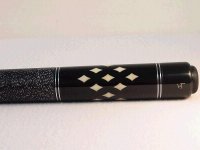Tommy-D said:> I've had several discussions about this with my machine shop instructor. He is a 20 yr vet tool and die maker,even though he's only 40. He says that in his experience,if a operator cannot cut a 3/8-12 Acme screw for example on a regular engine lathe,like most cuemakers use in some form or another,they sure as HELL can't program a CNC lathe to cut it,at least not without disastrous or fatal results. That tells me that even if you went out and spent 100k or more on a CNC machine,without proper training and acquired skill,all the technology and accuracy in that machine is totally useless. That is not saying that the CNC CAN'T be learned without a machinist background,but it sure as hell helps. In my mind,and I'm sure a LOT of others,all the CNC technology does is free up time for other things,by making certain procedures automated,such as cutting shaft blanks 4 at a time,with repeatable results. Unless it is a very complex part,and you have your entire CNC program totally "canned",you don't have time to just load up materials,hit the start button and go have lunch. My instructor tells me that unless he's really confident that the program he's written for a particular part will work flawlessly every time,he NEVER walks away from it. Whether rounded parts are cut with a pantograph,or CNC,they still require hand finishing skills to deburr them,etc. Some really skilled cuemakers use "primitive" tools such as X-Acto knives of different types and shapes to take a part that was bulk-cut with either a panto or CNC,which leave rounded edges because of the tools radius,and hand-finish them to complete sharpness. Like it or not,some people have that talent and some don't. I see things from both sides. I appreciate the things that CNC makes possible,and the talent and skills it takes to execute sharp inlays and perfect spliced points. That being said,as far as pure aesthetics,I honestly prefer rounded points/inlays,but not in all cases. Certain point styles and veneer/recut color combinations look much better sharp to me. Cuemakers that heavily use CNC,like Ernie for an example,are just making things more time-efficient,and should NOT be looked down upon for using what technology is available to them. The semi-mass produced cues like Joss,Schon and Pechauer may be looked at by some as "cookie-cutter" cues. But,ask yourself,other than some of the stuff Meucci makes,how many times have you really seen 2 IDENTICAL cues from them,that weren't a simple variation of a basic 4 point? Tommy D.
Tommy, well said.
